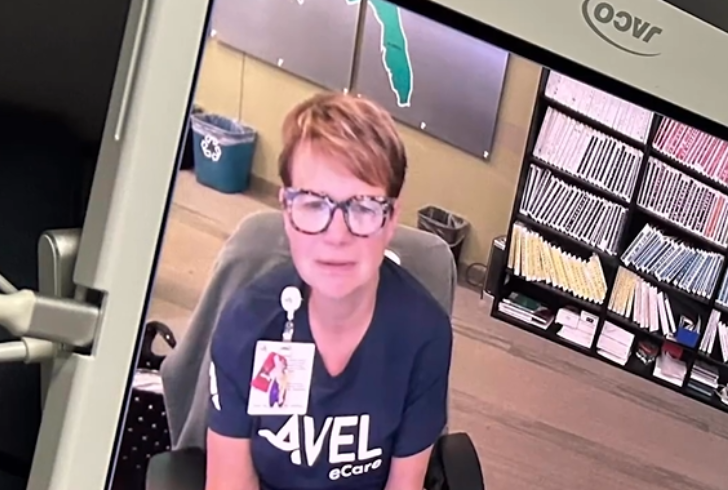
How Telehealth and Medical Technology Saved a Life in Rural America

In the heart of South Dakota, where vast landscapes define rural life, an unexpected danger befell rancher Jim Lutter. While checking on a sick bison calf, he found himself face to face with a 3-year-old bull named Bill, a companion he had raised since it was a tiny calf.
What followed was beyond anyone’s expectations as Bill, the seemingly docile bison, suddenly turned aggressive, hooking Lutter with its horns, tossing him into the air, and ultimately goring him in the groin.
In the aftermath of the brutal encounter, Lutter’s survival journey became a testament to the vital role of telehealth in the most unexpected of places – the back of a basic life support ambulance, navigating the vast rural expanse of South Dakota.
The Unexpected Lifeline: Telemedicine in Motion

Instagram | kffhealthnews | Jim Lutter’s harrowing bison incident significantly highlighted the Telemedicine in Motion initiative.
Rural areas often grapple with the scarcity of advanced medical resources. In South Dakota, where small towns like Gann Valley are home to a handful of residents, the challenge amplifies. However, in a groundbreaking initiative, the South Dakota Department of Health introduced “Telemedicine in Motion,” a project that seamlessly integrates telehealth solutions into ambulance services across the state.
Jim Lutter’s dramatic encounter with the bison became a pivotal moment for this initiative. As he lay in the back of an ambulance, bleeding profusely, a telehealth system connected the rural medics to an emergency medicine physician based 140 miles away in Sioux Falls. This innovative approach to emergency care marked a paradigm shift in how rural emergencies are addressed.
The Rancher’s Tale of Survival
Jim Lutter’s ordeal didn’t end with the bison attack. Unable to reach his cell phone, he demonstrated remarkable resourcefulness by climbing into a front-end loader and driving to his brother Lloyd’s house. Lloyd, in turn, initiated a race against time, calling 911 and driving towards the ambulance base 18 miles away.
The challenges faced by rural ambulance services like the one in Kimball are multifaceted. Insurance reimbursements often fall short of covering operational costs, and these services heavily rely on a diminishing pool of aging volunteers. Ed Konechne, a volunteer EMT with the Kimball Ambulance District, emphasizes the unique challenges faced by rural medics, highlighting the infrequency of severe cases like Lutter’s.
Remote Expertise: A Lifeline for Rural Medics

Instagram | kffhealthnews | DeJong’s remote guidance was crucial in saving Lutter’s life.
Katie DeJong, the emergency medicine physician at Avel eCare’s telehealth center, played a pivotal role in guiding the ambulance crew’s actions. Reacting to the severity of Lutter’s injuries, including a collapsed lung and a chest cavity filled with air and blood, DeJong orchestrated a coordinated response.
From instructing the rural hospital in Wessington Springs on the necessary preparations to arranging a helicopter transfer to a Sioux Falls medical center, DeJong’s remote expertise became the driving force behind Lutter’s life-saving journey. The video call not only facilitated real-time communication but also allowed the ambulance crew to focus entirely on the immediate care of the patient.
A Technological Lifeline Across the State
The telehealth system that played a crucial role in Lutter’s survival was part of the Telemedicine in Motion initiative, funded by $2.7 million from state funds and federal pandemic stimulus money.
Spearheaded by Avel eCare, the initiative involved the installation of video equipment in ambulances and comprehensive training for medics across the state.

Freepik | rawpixel.com | Currently, 75 out of 122 ambulance services in South Dakota have adopted this revolutionary technology.
As of now, 75 out of 122 ambulance services in South Dakota have embraced this transformative technology, with an additional 18 planning to follow suit. The system has been utilized approximately 700 times, underscoring its significance in enhancing emergency medical responses in rural areas.
The Future of Telehealth in Rural Emergency Services
While Avel eCare’s contract is set to conclude in April, the hope is that South Dakota will extend the Telemedicine in Motion initiative into a third year. The challenge ahead lies in sustaining the program once the initial funding ends. Jessica Gaikowski, spokesperson for Avel eCare, reassures that patients will not face additional charges for telehealth services, leaving the onus on ambulance services to decide on continued participation.
In the vast landscapes of South Dakota, where unexpected dangers lurk on tranquil ranches, the combination of rural resilience and cutting-edge telehealth solutions has proven to be a lifesaving partnership. Jim Lutter’s tale of survival serves as a testament to the transformative impact of technology in the most unforeseen corners of our lives.
More inMedicare
-
`
Are Popular Diet Trends Actually Good for Your Heart?
Diet trends grab headlines every year, promising everything from glowing skin to dramatic weight loss. But when it comes to the...
July 30, 2025 -
`
Why Are Men Taller Than Women? New Genetic Study Finds Clue
For centuries, the average height difference between men and women has been noticeable—men generally stand about five inches taller. While environment...
July 23, 2025 -
`
How Upcycled Beauty Ingredients Are Reshaping the Industry’s Future
The beauty industry is going through a big shift — and it’s not just about trends. As waste problems grow and...
July 17, 2025 -
`
A Look Inside Faith Kipyegon’s Groundbreaking Mile Run in Paris
Last week in Paris, Faith Kipyegon returned to a place she knows well: Stade Sébastien Charléty. But this time, she wasn’t...
July 9, 2025 -
`
Dairy Is Making a Major Comeback — And Health Shoppers Are Loving It
Just a few years ago, dairy sat quietly in the back seat while plant-based alternatives took the spotlight. Now, it’s stepping...
July 4, 2025 -
`
Does Aging Cause Dental Problems?
Aging doesn’t automatically mean losing teeth or developing gum disease. In fact, older adults today are holding onto more of their...
June 25, 2025 -
`
How Upcycled Ingredients Are Shaping the Future of Cosmetics
What used to end up in bins or compost heaps is now finding a new life inside skincare bottles and beauty...
June 18, 2025 -
`
Rock Legend Rod Stewart Trains to Break Sprint Record at 80
Age isn’t slowing Rod Stewart down. Known worldwide for his legendary voice, stadium-filling tours, and timeless hits like “Maggie May”, the...
June 11, 2025 -
`
The Truth Behind Detox Diets – Health Boost or Risky Trend?
It’s hard to scroll through your feed without seeing someone sipping green juice with promises of instant energy, glowing skin, and...
June 3, 2025














You must be logged in to post a comment Login